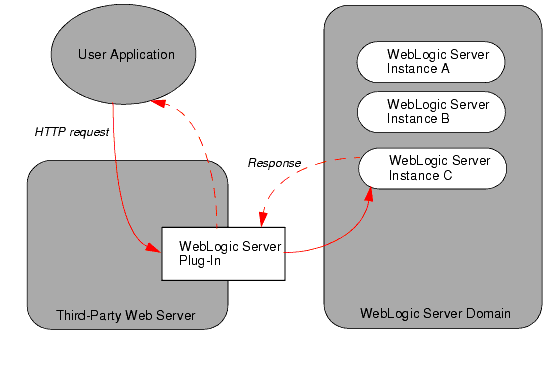Using Web Server Plug-Ins with WebLogic Server
|
|
Overview of Using Web Server Plug-Ins With WebLogic Server
The following sections give an overview of the plug-ins provided by BEA Systems for use with WebLogic Server:
- What Are Plug-Ins?
- Plug-Ins Included with WebLogic Server
- How Web Server Plug-ins Work with WebLogic Server
What Are Plug-Ins?
WebLogic Server plug-ins are modules that you add to your third-party Web server installation and configure to enable interactions between WebLogic Server and applications running on Apache HTTP Server, Sun One Web Server, and Microsoft Internet Information Server.
Plug-ins usually use one of the two following architectures to enable applications running on third-party Web servers to use the capabilities of WebLogic Server:
- As a load balancer for the Web server (proxying the requests to the backend servers)
- To proxy requests for dynamic content to backend servers (the Web server can supply only static content and relies on WebLogic Server for dynamic content)
In most cases the requests are initiated by the browsers or Web services or applets (using t3 tunneling over HTTP).
In a typical scenario, a third-party Web server receives a request from a user application and routes an HTTP request to the WebLogic Server plug-in, which uses its configuration information to to route the request to the WebLogic Server instance, server cluster, or array of unclustered servers. The targeted WebLogic Server instance or cluster processes the request (parses the headers, performs a requested action) and then returns a response via the plug-in to the third-party Web server.
WebLogic Server Plug-Ins do not support two-way SSL. However, the Plug-Ins can be set up to require the client certificate and pass it on to WebLogic Server. For example:
apache ssl
SSLVerifyClient require
SSLVerifyDepth 10
SSLOptions +FakeBasicAuth +ExportCertData +CompatEnvVars +StrictRequire
Plug-Ins Included with WebLogic Server
As of WebLogic Server 6.1 SP6, 7.0 SP5, and 8.1 SP2, the WebLogic Server plug-ins are now certified to proxy to any version of WebLogic Server, including 5.1
WebLogic Server includes plug-ins for the following Web servers:
- Apache HTTP Server: a shared object
- Microsoft Internet Information Server: a dynamic link library and an .ini file.
- Sun One Web Server:
How Web Server Plug-ins Work with WebLogic Server
In Figure 1-1, a user application running on a third-party Web server generates an HTTP request, which the Web server routes to the WebLogic Server plug-in. The plug-in sends the HTTP request based on configuration information that specifies a WebLogic Server cluster or instance. The WebLogic Server instance processes the request and returns a response to the user application through the plug-in.
Figure 1-1 Role of WebLogic Server Plug-In
In this scenario, the WebLogic Server plug-in configuration parameter WebLogicHost specifies WebLogic Server instance C as the recipient of the HTTP request.
You target a WebLogic Server instance using the WebLogicHost and WebLogicPort parameters in the plug-in configuration file. You target a WebLogic Server cluster or group of non-clustered servers using the WebLogicCluster parameter. For information about setting plug-in parameters, see Parameters for Web Server Plug-Ins.
Proxying Requests
The plug-ins proxy requests to WebLogic Server based on configuration information that you specify. You can proxy requests based on either the URL of the request or a portion of the URL. This is called proxying by path.
You can also proxy a request based on the MIME type of the requested file, which called proxying by file extension.
You can also enable both methods. If you do enable both methods and a request matches both criteria, the request is proxied by path.
You can also specify additional parameters for requests that define additional behavior of the plug-in. For more information, see the following sections on on how to configure each plug-in:
